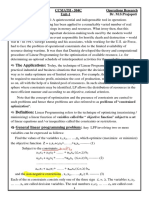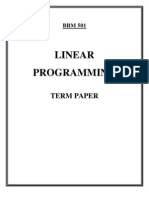Notes on Linear Programming Problems
Uploaded by
2004rakshitnayalNotes on Linear Programming Problems
Uploaded by
2004rakshitnayalLINEAR PROGRAMMING PROBLEMS
In business management there are many activities such as production, inventory,
marketing, maintenance etc. Many times, the situations are complex. The variables
involved behave adversely and they have conflicting effects. In this situation one has
to find a golden mean of a break-even point. A set of several techniques to achieve
such a solution is developed around 1940, it is now referred as ‘Operational
Research’.
Meaning of Linear Programming Problem
The meaning of the word programme is the plan of action. Particularly linear
programming is a problem of minimising or maximising the objective function, which
is linear in nature, subject to the constraints which are also linear in nature
In order to solve the problems using methods in Operational Research we need to go
through the following steps:
1. Decide the model to be used to solve the problem.
2. Formulation of the problem.
3. Use of appropriate technique to get the best or optimal solutions.
Decision Variables: In the formulation of L.P.P or any model in operations research
one has to decide the unknowns to be found out. These unknowns are called as
decision variables. The decision variables may take non-negative values or they are
unrestricted in sign.
Constraints: The conditions, limitations in the given problem are expressed in terms
of equations or inequalities in terms of decision variables are called as constraints. In
L.P.P the constraints are linear in nature.
Objective Function: The goal or objective to be achieved in the model is called as
objective function. It is to be maximised or minimised (optimised) In L.P.P the
objective function is linear in nature.
The function is to be maximised or minimised we call it as to be Optimised.
Thus, the problem reduces to three ingredients.
1. Identify the Decision Variables
2. Identify the Constraints
3. Identify Objective Function
Feasible Solution: The solution which is confined to the constraints.
The L.P.P after formulation with x and y as the decision variable is of the type:
Maximize/Minimize Z = c1x + c2y Objective Function
Subject to a11x + a12y (≤, =, ≥) b1
a21x + a22y (≤, =, ≥) b2
………………………..
………………………
am1x + am2y (≤, =, ≥) b1 Constraints
x, y ≥ 0 (or restricted) Non – negativity Restrictions
The linear objective function involves the coefficients c1 and c2 may be costs or
profits or time required or efficiencies etc. with respect to the variables x and y
respectively.
Solution of L.P.P by Graphical Method
1. Solution: A set of values of decision variables which satisfy the constraints of
LPP is called as solution to corresponding L.P.P
2. Feasible Solution: A solution which satisfies the non-negativity restrictions
of L.P.P is called as feasible solution to corresponding L.P.P
3. Optimal Solution: A feasible solution of L.P.P which optimizes (maximizes
or minimizes) the objective function is called as optimal solution of the
corresponding L.P.P
4. Unique Optimal Solution
5. Multiple Optimal Solution: This situation arises when the line given by
objective function is parallel to any of the boundary of the feasible region.
The two vertices by such constraint will give the optimal solutions with the
same value of z. In fact, every point joining these two points will a solution to
L.P.P Thus, there will be multiple or infinitely many solutions.
6. Unbounded Solution: The feasible region may be unbounded with
unbounded value of z
7. No Solution or Infeasible Solution: If there is no point in the feasible region
which satisfies all the constraints then L.P.P has no optimal solution.
8. Degenerate Solution: If any of the decision variable is 0 in the optimal
solution then the solution is degenerate. If the vertex at which optimal
solution exists is on any of the axis, then degenerate solution is possible. This
situation will arise if:
i. There is only one constraint
ii. The objective function has one variable
iii. The cost coefficients c1 and c2 differ too much relatively.
PROBLEMS
1. A manufacturing company produces two types of batteries low volt and
medium volt. A low volt battery requires 1 hour processing time on machine
and 2 hours of labour time. A medium volt battery requires 2-hour processing
time on machine and 1.5 hours of labour time. In a week, processing machine
is available for 70 hours and labour time available is 60 hours. The profit due
to each of the low volt battery is Rs. 60 where as due to medium volt battery it
is Rs. 75.
Formulate the problem as L.P.P with a view to maximize the total profit and
solve it graphically.
2. A and B are two types of fertilizers available at Rs 30 per kg and Rs. 50 per kg
respectively. Fertilizer A contains 20 units of potash, 10 units of nitrogen and
40 units of phosphorus. Fertilizer B contains 15 units potash, 20 units of
nitrogen and 10 units of phosphorus. The requirement of potash, nitrogen and
phosphorus is at least 1800,1700,1600 units.
Formulate the problems as L.P.P in order to minimize the total purchasing
cost. Also obtain the solution using graphical method.
You might also like
- 2306 9MA0-31 A Level Statistics - June 2023 (Word)No ratings yet2306 9MA0-31 A Level Statistics - June 2023 (Word)8 pages
- Linear Programming Problem: Basic RequirementsNo ratings yetLinear Programming Problem: Basic Requirements5 pages
- (Operation Research 1) CC MATH-504C Unit-1-2-3No ratings yet(Operation Research 1) CC MATH-504C Unit-1-2-346 pages
- Linear Programmin G: by Nagendra Bahadur Amatya Head of DepartmentNo ratings yetLinear Programmin G: by Nagendra Bahadur Amatya Head of Department29 pages
- Bus 403 - Analysis of Business Decisions - LPPNo ratings yetBus 403 - Analysis of Business Decisions - LPP14 pages
- B.Com 4th Semb - Math Revision Class Study Materials - Unit-5 To Be UploadedNo ratings yetB.Com 4th Semb - Math Revision Class Study Materials - Unit-5 To Be Uploaded17 pages
- 1.1. Formulation of LPP: Chapter One: Linear Programming Problem/LPPNo ratings yet1.1. Formulation of LPP: Chapter One: Linear Programming Problem/LPP54 pages
- Ramkrishna Mahato Government Engineering CollegeNo ratings yetRamkrishna Mahato Government Engineering College7 pages
- Linear Programming: by Nagendra Bahadur Amatya Head of DepartmentNo ratings yetLinear Programming: by Nagendra Bahadur Amatya Head of Department29 pages
- Or Unit 1 Long 1 Ans: Characteristics of Operations ResearchNo ratings yetOr Unit 1 Long 1 Ans: Characteristics of Operations Research9 pages
- Linear Programming I: Formulation and Graphic Solution: X X X Objective Function X X X X X XNo ratings yetLinear Programming I: Formulation and Graphic Solution: X X X Objective Function X X X X X X3 pages
- OR Chapter 2 Linear Programming Application and Model Part I67% (3)OR Chapter 2 Linear Programming Application and Model Part I13 pages
- FHMM1314 MBI Topic 3 Student Version 202301No ratings yetFHMM1314 MBI Topic 3 Student Version 20230158 pages
- Lecture 2-Linear Programming With Graphical MethodNo ratings yetLecture 2-Linear Programming With Graphical Method11 pages
- STAT 606 - Some Empirical Methods Slides - 2019 - 2020No ratings yetSTAT 606 - Some Empirical Methods Slides - 2019 - 202039 pages
- Dynamic Programming Longest Common SubsequenceNo ratings yetDynamic Programming Longest Common Subsequence3 pages
- Unit 4 - Activity 1 - Scatter Plots and Linear Correlation WorksheetNo ratings yetUnit 4 - Activity 1 - Scatter Plots and Linear Correlation Worksheet4 pages
- A Fast and Shorter Path Finding Method For Maze Images by Image Processing Techniques and Graph TheoryNo ratings yetA Fast and Shorter Path Finding Method For Maze Images by Image Processing Techniques and Graph Theory5 pages
- PID Tuning Assignment: Sir Dr. Ali MughalNo ratings yetPID Tuning Assignment: Sir Dr. Ali Mughal7 pages
- "Deep" Learning For Missing Value Imputation in Tables With Non-Numerical DataNo ratings yet"Deep" Learning For Missing Value Imputation in Tables With Non-Numerical Data9 pages
- Nama: Sekar Sari NIM: 1500022033 Tugas Pengolahan Sinyal Digital Lanjut 6 Juli 18'No ratings yetNama: Sekar Sari NIM: 1500022033 Tugas Pengolahan Sinyal Digital Lanjut 6 Juli 18'8 pages
- Fraud call detection using conversation analyzerNo ratings yetFraud call detection using conversation analyzer6 pages
- New mixed-integer linear programming model for solving the multidimensional multi-way number partitioning problemNo ratings yetNew mixed-integer linear programming model for solving the multidimensional multi-way number partitioning problem72 pages
- Airline Passenger Satisfaction Prediction: Sheila Fitria Al'asqalaniNo ratings yetAirline Passenger Satisfaction Prediction: Sheila Fitria Al'asqalani22 pages
- Photo-Realistic Single Image Super-Resolution Using A Generative Adversarial NetworkNo ratings yetPhoto-Realistic Single Image Super-Resolution Using A Generative Adversarial Network19 pages
- 19cse214: Theory of Computation: Case Study ReportNo ratings yet19cse214: Theory of Computation: Case Study Report4 pages
- Automatic Control Systems 9th Edition Farid Golnaraghi - Discover the ebook with all chapters in just a few seconds100% (1)Automatic Control Systems 9th Edition Farid Golnaraghi - Discover the ebook with all chapters in just a few seconds57 pages
- Statistical Analysis Which To Choose (Multivariable) 2021No ratings yetStatistical Analysis Which To Choose (Multivariable) 202122 pages
- Performance Comparison of Simple Regression Random Forest and XGBoost Algorithms For Forecasting Electricity DemandNo ratings yetPerformance Comparison of Simple Regression Random Forest and XGBoost Algorithms For Forecasting Electricity Demand7 pages
- CCL_leadership-challenge-ladder-technical-reportNo ratings yetCCL_leadership-challenge-ladder-technical-report42 pages

























































































